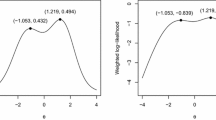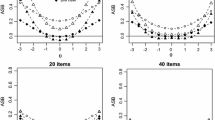Abstract
Using an infinite item test framework, it is argued that the usual assumption of local independence be replaced by a weaker assumption,essential independence. A fortiori, the usual assumption of unidimensionality is replaced by a weaker and arguably more appropriatestatistically testable assumption of essential unidimennsionality. Essential unidimennsionnality implies the existence of a “unique” unidimensional latent ability. Essential unidimensionality is equivalent to the “consistent” estimation of this latnet ability in an ordinal scaling sense using anyBalanced empirical scaling. A variation of this estimation approach allows consistent estimation of ability on the given latent ability scale.
Similar content being viewed by others
References
Cliff, N. (1977). A theory of consisitency of ordering generalizable to tailored testing.Psychometrika, 42, 375–399.
Cliff, N. (1979). Test theory without true scores?Psychometrika, 44, 373–393.
Cliff, N. (1989). Ordinal consistency and ordinal true scores.Psychometrika, 54, 75–92.
Cliff, N., & Donoghue, J. R. (1990). Ordinal test fidelity estimated from an item sampling model. Unpublished manuscript.
Hambleton, R. K., & Swaminathan, H. (1985).Item response theory: Principles and applications, Boston: Kluwer Nijhoff.
Holland, P., Junker, B., & Thayer, D. (1987). Recovering the ability distribution from test scores. Unpublished manuscript, Educational Testing Service, Princeton, NJ.
Humphreys, L. (1984). A theoretical and empirical study of the psychometric assessment of psychological test dimensionality and bias (ONR Research Proposal). Washington, DC: Office of Naval Research.
Junker, B. (1988).Statistical aspects of a new latent trait model, unpublished doctoral dissertation, University of Illinois at Urbana-Champaign, Department of Statistics.
Lord, F. M. (1980).Applications of item response theory to practical testing problems. Hillsdale, NJ: Lawrence Erlbaum.
Lord, F. M., & Novick, M. R. (1968).Statistical theories of mental test scores. Reading, MA: Addision-Wesley.
McDonald, R. P. (1981). The dimensionality of tests and items.British Journal of Mathematical and Statistical Psychology, 34, 100–117.
McDonld, R. P., & Mulaik, S. A. (1979). Determincy of common factors: A nontechnical review.Psychological Bulletin, 86, 297–306.
Mislevy, R. J. (1987). Recent devcelopments in IRT. In E. Z. Rothkoph (Ed.),Review of research in education (Vol. 14, 239–275, ETS preprin). Washinton, DC: American Educational Research Association.
Mokken, R., & Lewis, C. (1982). A nonparametric approach to dichotomous item responses.Applied Psychological Measurement, 6, 417–430.
Mulaik, S. A., & McDonald, R. P. (1978). The effect of additional variables on factor indetermancy in models with a single common factor.Psychometrika, 43, 177–192.
Reckase, M. D., Carlson, J. E., Ackerman, T. A., & Spray, J. A. (1986, June). The interpretation of unidimensional IRT parameters when estimated from multidimensional data. Paper presented at the Annual Meeting of the Psychometric Society, Toronto.
Sijtsman, K., & Molenaar, I. (1987). Reliability of test scores in nonparametric item response theory.Psychometrika, 52, 79–98.
Stout, William (1987). A nonnparametric approach for assessing latent trait dimensionality.Psychometrika, 52, 589–618.
Tucker, L. R., Koopman, R. F., & Linn, R. L. (1969). Evaluation of factor analytic research procedures by means of simulated correlation matrices.Psychometrika, 34, 421–459.
Wang, M. (1988). Measurement bias in the application of a unidimensional model to multidimensional item-response data. Unpublished manuscript, Educational Testing Service, Princeton, NJ.
Author information
Authors and Affiliations
Additional information
I wish to thank Brian Junker for useful comments and discussions resulting from his careful and thoughtful reading of the manuscript. I wish to thank Charles Davis for useful comments that lead to several improvements, in particular in section 3 and 4. I wish to thank D. R. Divgi for an insight that lead to a useful reformulation of essential independence. Lloyd Humphreys' steadfast insistence that tests items are inherently “multiply determined” provided the empirical grounding for essential dimensionality. Remarks by Mark Reckase and Ming-mei Wang were also helpful.
This research was supported by Office of Naval Reserch Grant N00014-87-K-0277 and National Science Foundation Grant NSF-DMS-88-02556.
Rights and permissions
About this article
Cite this article
Strout, W.F. A new item response theory modeling approach with applications to unidimensionality assessment and ability estimation. Psychometrika 55, 293–325 (1990). https://doi.org/10.1007/BF02295289
Issue Date:
DOI: https://doi.org/10.1007/BF02295289
Key words
- Local independence
- essential independence
- essential trait
- intrinsic ability scale
- marginal item responnse function
- latent dimensionality
- multidimensionality
- essential unidimensionnality
- item response theory
- latent trait theory
- ability estimationn
- consistent estimationn
- nonparametric
- balanced linear formula score
- infinite item pool




